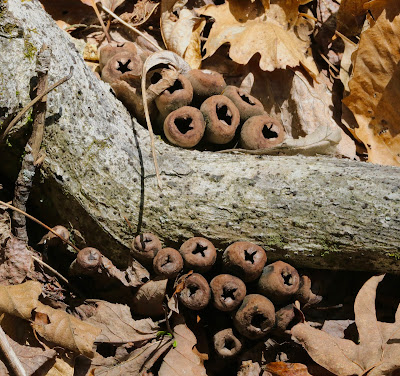 |
| Black Fork Falls. |
Twin Falls Resort State Park in West Virginia is host to a Tracking and Woods Lore weekend workshop every year. When I heard about it, I thought it would be an excellent way for Jasper and I to immerse ourselves in learning about the natural history and early colonial history of the area.
 |
| Partridge berries. |
The prices were very reasonable, and my husband was able to come along at no extra charge to relax and paint some watercolors while we attended our workshops. It was a delightful vacation. The Tracking and Woods Lore weekend was presented by Doug Wood and his wife Dianne Anestis, with Mike Little and Sue Little, for
Trails Living History. I believe they've been presenting this weekend workshop there for many years, but usually they've been scheduling it in January when animal tracking in the snow would be optimal. Scheduling it in the spring meant the ability to focus also on amphibians and reptiles, as well as ethnobotany (aka "useful plants"), since there were plenty in evidence. Without snow, we found more animal signs than animal tracks.
 |
| Golden ragwort. |
We also were treated to several really terrific living history presentations focused on frontier life in the 1700s. Some fascinating details we learned: Early colonists coming from Europe would have had a great deal of trouble feeding themselves. Livestock would have been easy prey for wild animals. And in Europe, only landowners were allowed to hunt. (There were more of these folks eager to settle in America than you might think; inheritance laws in Europe tended to heavily favor first born sons, so colonizing seemed attractive to many younger brothers who came from wealthy families.) The common man with no hunting skills had to either rely on someone else who could hunt, or learn how to hunt for himself in a big hurry.
The fashion for European men was to display as many buttons as they could afford. This might mean more buttons than actual functional buttons with button holes. They were made from shell, pewter, silver, wood, or thread (and making buttons from thread is very tedious!). But most certainly not for women; they used hooks and eyes, or simply ties (and ties were used for children's clothes as well). European shoes were laced in a spiral fashion instead of the criss-cross fashion of today. They quickly came to appreciate Native American moccasins, especially because they could make them for themselves. Native Americans liked to trade for European style shirts, and if they were intended for natives, they were often made without a collar or cuffs. Europeans were in the habit of washing their clothes but not themselves! Native Americans, on the other hand, washed themselves religiously every day, but did not wash their clothes. Unfortunately, you gotta do both if you want to avoid body lice...
When someone tells you that a food has a bitter taste, you probably don't start to drool. But in early colonial times, people did not have easy access to sweeteners, and bitter flavors were much more appreciated. (Too bad we don't still have as much enthusiasm for highly invasive, bitter garlic mustard as we did when we brought it here!)
 |
Amphibian egg masses. I believe the smaller ones are mountain chorus frogs,
and the larger ones are four toed salamander eggs. |
 |
| Doug Wood showing us a four toed salamander nest. |
We stopped to see some four toed salamander nests. The female lays her eggs under moss near a vernal pool, and stays around them for a while before they hatch. Interestingly, no one is positive why, because she apparently doesn't really guard her eggs. Her skin secretions might help ward off fungus from growing on the eggs. Sadly, we found all the nests disturbed and no females present, possibly due to the mischief of wild turkeys. They weren't too interested in the amphibian eggs, but might have disturbed the nests looking for some tasty mother salamanders!
 |
| Mountain chorus frog. |
 |
| This violet's intriguing white splotches are caused by a mosaic virus, the same family of viruses that infected Dutch tulip bulbs in the 1600s. It gave the tulip flowers an etherial beauty, but also killed them. |
 |
| Ant babies. (What are ant babies called? Cosins?) |
 |
| Eastern box turtle. The turtle was very much in hiding! I can't help but find it exciting that turtles this size are trundling through our forests. |
 |
| Mountain chorus frog. |
 |
| Marsh Fork Falls. |
 |
| Violets. |
 |
| Black Fork Falls. |
 |
| Violet with jumping spider visitor. |
 |
| Periwinkle. |






















Comments
Post a Comment
Hello! I love to read your comments, but please be aware that they are moderated. This will result in a delay before they are posted. Thank you for your patience.